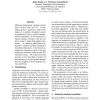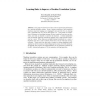COLING
2000
14 years 4 months ago
2000
We have implenlented a.n interactive, Wel)-based, chat-style machine translation system, SUpl)ort;ing speech recognition and synthesis, local- or thirdparty correction of speech r...
ACL
2001
14 years 4 months ago
2001
We present a machine learning approach to evaluating the wellformedness of output of a machine translation system, using classifiers that learn to distinguish human reference tran...
ACL
2006
14 years 4 months ago
2006
Obtaining high-quality machine translations is still a long way off. A postediting phase is required to improve the output of a machine translation system. An alternative is the s...
LREC
2008
14 years 4 months ago
2008
This paper deals with the treatment of constructed neologisms in a machine translation system. It focuses on a particular issue in Romance languages: relational adjectives and the...
FINTAL
2006
14 years 6 months ago
2006
When building rule-based machine translation systems, a considerable human effort is needed to code the transfer rules that are able to translate source-language sentences into gra...
ICTAI
1994
IEEE
14 years 7 months ago
1994
IEEE
Large-scale lexical knowledge acquisition is one of the most time critical steps in developing a knowledge-based machine translation system. In particular, developing the syntacti...
AMTA
1998
Springer
14 years 7 months ago
1998
Springer
This paper describes the integration of a Turkish generation system with the KANT knowledge-based machine translation system to produce a prototype English
AMTA
1998
Springer
14 years 7 months ago
1998
Springer
Cross-language retrieval systems use queries in one natural language to guide retrieval of documents that might be written in another. Acquisition and representation of translation...
AMTA
1998
Springer
14 years 7 months ago
1998
Springer
This paper describes the progress of a machine translation system from Chinese to English. The system is based on a reusable platform of MT software components. It's a rule-ba...
ECML
2003
Springer
14 years 8 months ago
2003
Springer
In this paper we show how to learn rules to improve the performance of a machine translation system. Given a system consisting of two translation functions (one from language A to ...


